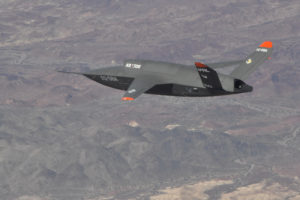NATIONAL HARBOR, Md. – The Air Force is planning its first display of what its Advanced Battle Management Concept (ABMS) would operationally look like within the next few months, the service’s top acquisition officer said Sept. 17.
An experiment involving a Skyborg unmanned aerial system connected to an F-22 Raptor and an F-35 Joint Strike Fighter and all three networked to a group operator will be “what you could call step one for ABMS,” Assistant Secretary for Acquisition, Technology and Logistics Will Roper told reporters at the Air Force Association’s Air, Space and Cyber conference here.

The three aircraft would be connected through “cloud-based networking and data-sharing, even down to a handset on the ground like an iPad-type device where a ground operator could interface with the same systems in the sky,” Roper said.
The goal is to perform this demonstration quickly as it will incorporate high-end systems and attritable aircraft with ground operators in a way that will inform the networked environment concept of multi-domain operations that the Air Force envisions will be the battlefield of the future.
“Once we do this, we hope that this idea of the power of the network will keep growing,” Roper said.
It’s not yet clear what the participating UAS would actually be.
Roper first announced the Skyborg project this past March, calling it a “quarterback in the sky” that would train alongside pilots and eventually partner with attritable aircraft to extend the Air Force’s reach in denied or contested air environments (Defense Daily, March 27). It was stood up as a fiscal year 2019 pathfinder project through the service’s office of Strategic Development, Planning and Experimentation (SDPE).
The service has been conducting Skyborg-related tests with the XQ-58A Valkyrie, a long-range, high subsonic unmanned aerial vehicle developed by the Air Force Research Lab and Kratos Defense and Security Solutions [KTOS]. Two test flights have occurred in 2019, with three more scheduled by the end of the year (Defense Daily, June 17).
Air Force Materiel Command Commander Gen. Arnold Bunch told reporters Tuesday that the specific platform to be used in the demonstration remains to be seen.
“We’re in the early stages of developing the plan, so I can’t tell you exactly how that’s going to work yet,” he said. “It could be the one we’ve flown before that you’ve seen, or it could be something else.”
The concept of ABMS was launched when the Air Force convinced Congress to cancel the expected recapitalization program for the Joint Surveillance Target Attack Radar System (JSTARS) program in the fiscal year 2019 National Defense Authorization Act (NDAA) and instead use that money to work toward a “family of systems” concept that connects new and existing platforms for battlefield command-and-control and other
The question of ABMS should inform future decisions about Air Force platforms, Roper noted. As service leaders decide what the Air Force of the future looks like, the decision of whether to sustain or retire a system “should go hand-in-hand with what can be easily upgraded to be networked into the Internet of Things Air Force.”